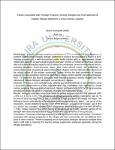Factors Associated with Teenage Pregnancy Among Refugees and Host Nationals of Palabek Refugee Settlement, Lamwo District, Uganda.
Date
2022Author
Okiror, Emmanuel Okello
Acen, Joy
Sharon, Bright Amanya
Metadata
Show full item recordAbstract
Background: Uganda’s teenage pregnancy prevalence of 25% is remarkably high. However, in northern Uganda where Palabek Refugee Settlement is located, the prevalence is higher at 31%. Teenage pregnancy is a well-documented public health burden with an approximated sixteen million girls aged 15–19 years old giving birth each year; of these 12 million are from Sub-Saharan Africa and other developing regions and 10 million are unintended. Several environmental factors, including education, socio-economic status, local socio-cultural norms, the availability of contraceptives, and occupational opportunities affect refugees and host nationals alike. Because of the unique nature of the refugee community, factors driving the high prevalence of teenage pregnancy in this population need to be identified to devise context-specific preventive strategies.
Aim: To determine the factors associated with teenage pregnancy among refugees and host nationals of Palabek Refugee settlement, Lamwo district, Uganda.
Methods: This was a cross sectional study utilizing quantitative methods of data collection using a structured questionnaire as a data collection tool. The respondents were selected by simple random sampling. Data was entered into excel, cleaned, and loaded into SPSS V.26 for processing and analysis which was done at Univariate, bivariate and multivariate levels.
Results: Refugees were two times more likely to getting pregnant than the host nationals (OR: 1.793, C.I; 1.092 to 2.943. The prevalence of teenage pregnancy among respondents was 41.7% and that of early marriages was 29.9%, an evidence of high prevalence of teenage marriages. The following factors were significantly associated with teenage pregnancy status – age group of the respondent, school attendance, marital status of the teenager, occupation of teenager, age at first sex, alcohol use, teenager’s mother’s level of education and person teenager lives with all with p < 0.001; media exposure (p=0.005); history of sexual abuse (p=0.049); whether parents of the teenager were divorced/separated or not (p<0.033) and cultural norms on sex (p=0.025).
Conclusion: The burden of teenage pregnancy is still significant in these communities. The factors associated with teenage pregnancy in the refugee and host communities are not different from those in other contexts. Therefore adopting and or formulating strategies directed to mitigate these factors will help in reducing the soaring teenage pregnancies witnessed especially among the refugee populations.

